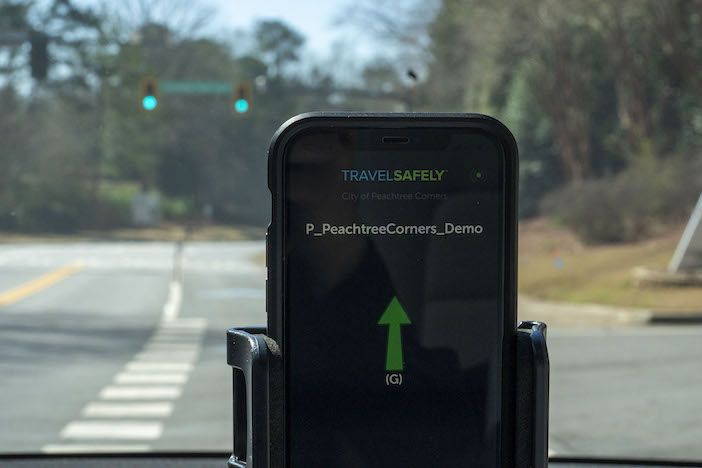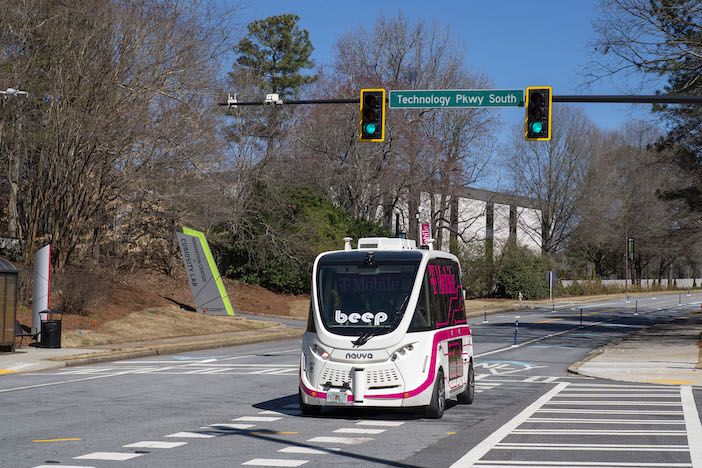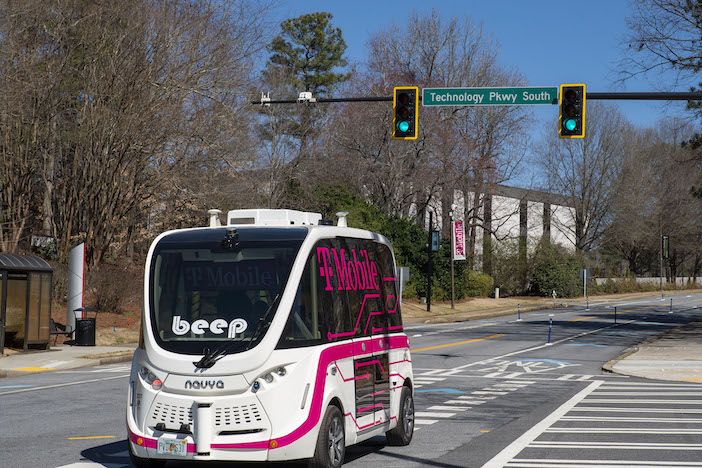Peachtree Corners – one of the USA’s first smart city environments powered by real-world connected infrastructure and 5G – has announced that T- Mobile, Applied Information and Temple, Inc. are introducing 5G-connected vehicle technology that enables traffic signals to communicate with any vehicle on the road via a revolutionary mobile app.
This technology enables two-way communication on T-Mobile’s 5G network between the traffic signal and devices such as smartphones, tablets and vehicles equipped with on-board-units. The TravelSafely smartphone app provides audible warnings about potential red light running and alerts to get ready for green. Communications from the vehicle to the traffic signal can enable normal calls for a green light or green light preemption – or even priority in special cases, such as public safety.
The collaboration is part of a partnership between the Curiosity Lab at Peachtree Corners and the Infrastructure Automotive Technology Laboratory (iATL) to accelerate the development and deployment of connected vehicle safety applications and transportation infrastructure technologies.
The two organizations, along with development partners such as T-Mobile, will share assets and facilities on projects involving automakers and technology innovators to develop and rapidly mainstream new safety systems for mobility. The partners will also promote the region as a hub for connected vehicle innovation and work to attract future development and early deployment to the area.

“As another strong reflection of Peachtree Corners’ leadership as an innovative smart city in the United States, we’re excited to offer smart connected infrastructure relevant to our citizens, city employees and visitors by enabling any vehicle to receive communications from 5G-connected traffic signals,” says Brian Johnson, city manager of Peachtree Corners. “Cellular vehicle-to-everything (C-V2X) technology isn’t just a concept here, it’s a reality that all people can experience just by downloading an app on their smartphones. This is truly the city street of the future, reminding us again of how important it will be for key elements of a city to communicate with each other to elevate safety and improve the daily lives of residents.”
In addition to English, the app provides the warnings and alerts in Spanish, Korean, Hindi, Simplified Chinese, French and German – depending on the phone settings of the user.
 “The evolution from 4G to 5G brings revolutionary advances in the performance of connected vehicle applications. This powerful collaboration enables the industry to accelerate the pace of change for the better and make for safer travel for all,” says president of Applied Information and executive director of the iATL, Bryan Mulligan
“The evolution from 4G to 5G brings revolutionary advances in the performance of connected vehicle applications. This powerful collaboration enables the industry to accelerate the pace of change for the better and make for safer travel for all,” says president of Applied Information and executive director of the iATL, Bryan Mulligan
As further reflection of the city street of the future coming to life, four autonomous shuttles operated by mobility-as-a-service leader, Beep Inc., integrate Applied Information’s C-V2X technology into their fleet for safe and precise navigation, as well as real-world data collection. Multi-modal interoperability at intersections, as well as testing signal prioritization for the autonomous shuttle fleet, are just a few examples of critical situations. As transit operations and the need to safely test autonomous platforms while efficiently moving people around cities continues to grow, these real-world applications and tests help drive society forward.
“We have the experience of safely testing autonomous platforms in real-world use cases within the first smart city environment in the United States. Completing the vehicle-to-infrastructure equation with communication between drivers, pedestrians, roadside units, traffic signals, buildings and other city-owned infrastructure is critical for both driven and driverless vehicles. Advanced C-V2X technology on our platforms elevates each vehicle’s awareness of its surroundings and is invaluable as we develop more unique technologies to further elevate safety and advance the AV industry,” says Joe Moye, CEO of Beep.

Data collected from this deployment will help roadway operators and traffic technology developers better understand the performance of the 5G network to deliver safety messages to drivers and directly to equipped vehicles.
“The future of 5G technology is being realized with each innovation, in large part due to strong partnerships such as ours with Peachtree Corners at the Curiosity Lab. This step forward in safety technology is an integral moment in our pursuit of more connected and more autonomous vehicles. With our unmatched 5G coverage, and the exciting work at Curiosity Lab, we look forward to a future of smarter vehicles and, importantly, safer roads,” says Dave Bezzant, vice president, T-Mobile for government





